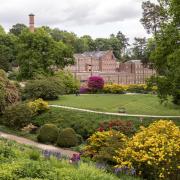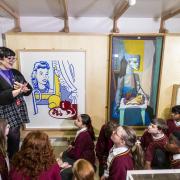A appreciation of Mary of Magdela, Startled in a Wood, by Herbert Gustave Schmalz
Mary of Magdela, Startled in a Wood was painted in 1893 by Herbert Gustave Schmalz. It is a hidden pre-Raphaelite gem in the most unlikely of settings.
It is one of several of his works that portray the resurrection of Jesus. Mary Magdalene was the first person to see Jesus after his resurrection and that moment is captured beautifully here.
Mary has come to visit the tomb of Jesus, only to discover it open, and empty. She flees in fright but is stopped in her tracks by the sight of a stranger. She cannot believe what her eyes are telling her. Could that be Jesus who holds her gaze?
The style is heavily influenced by the pre-Raphaelites. Mary is pale skinned with long, flowing auburn hair. She is an English rose in a very English looking woodland scene. In front of the empty tomb, the grave clothes used to cocoon the body of Jesus lie discarded. They are accompanied by a lone spear dropped in haste by a fleeing guard.
Schmalz was a talented artist born in Newcastle-upon-Tyne to an English mother and German father. He burst onto the London art scene in the 1880s and looked destined to achieve great things. Sadly his career stalled; an influx of vibrant new artistic movements started by the Impressionists made his style look very old-fashioned. The wave of anti-German sentiment in World War 1 caused him to adopt his mother’s maiden name of Carmichael and his profile virtually vanished.
Schmalz was supported in his early days by Charles Nevill of Bramall Hall where several other works by Schmalz can still be seen. After the First World War Nevill’s business suffered and despite being forced to sell many of his possessions, including Bramall Hall, he opted to donate two of his prized Schmalz paintings to local churches. ‘Rabboni’ was given to St Paul’s in Portwood which closed in 1971 when the painting was given back to Bramall Hall where it now graces the chapel. Mary of Magdela was given to Christ Church in Chester where it can still be seen.
Why you should see this painting:
This late Victorian painting epitomises the pre-Raphaelite ideals of beauty and nature. It is hidden away in an unlikely but accessible and atmospheric setting.
Where you can see this
Christ Church is located a short walk from Chester city centre on Gloucester Street, CH1 3HR. Admission is by appointment or around the times of church services. n



























